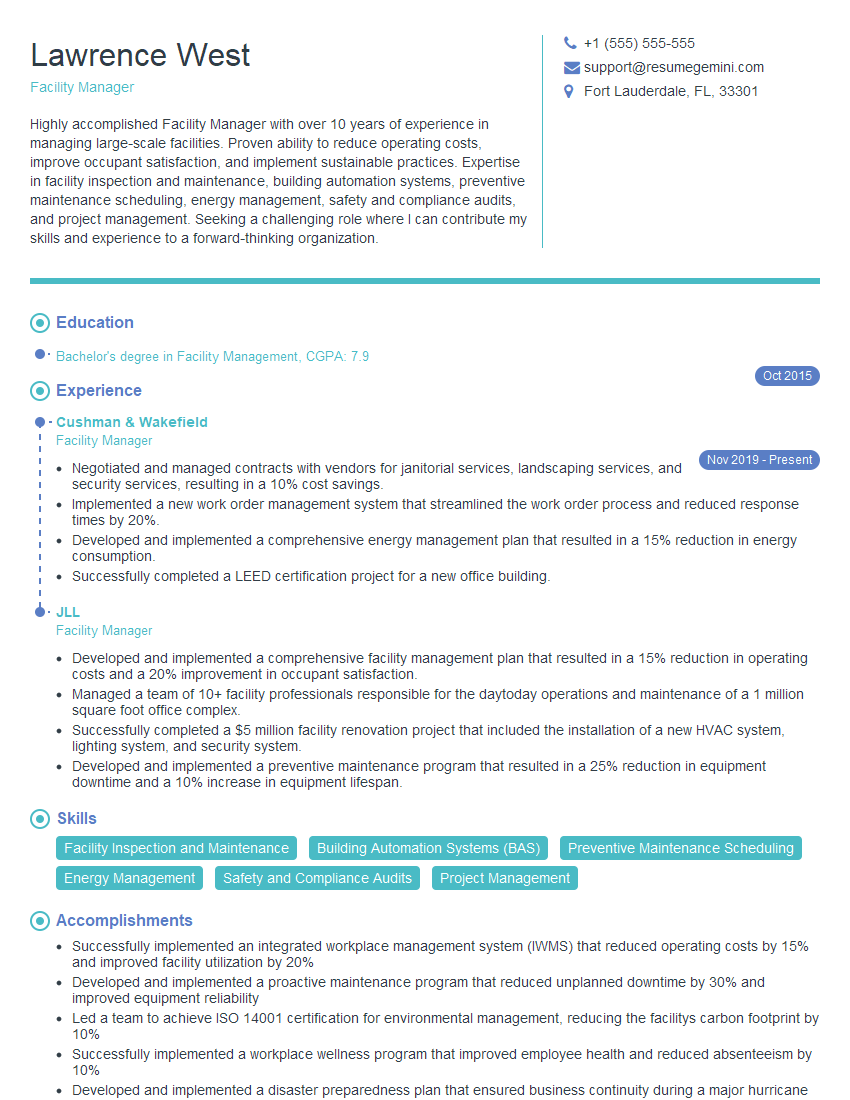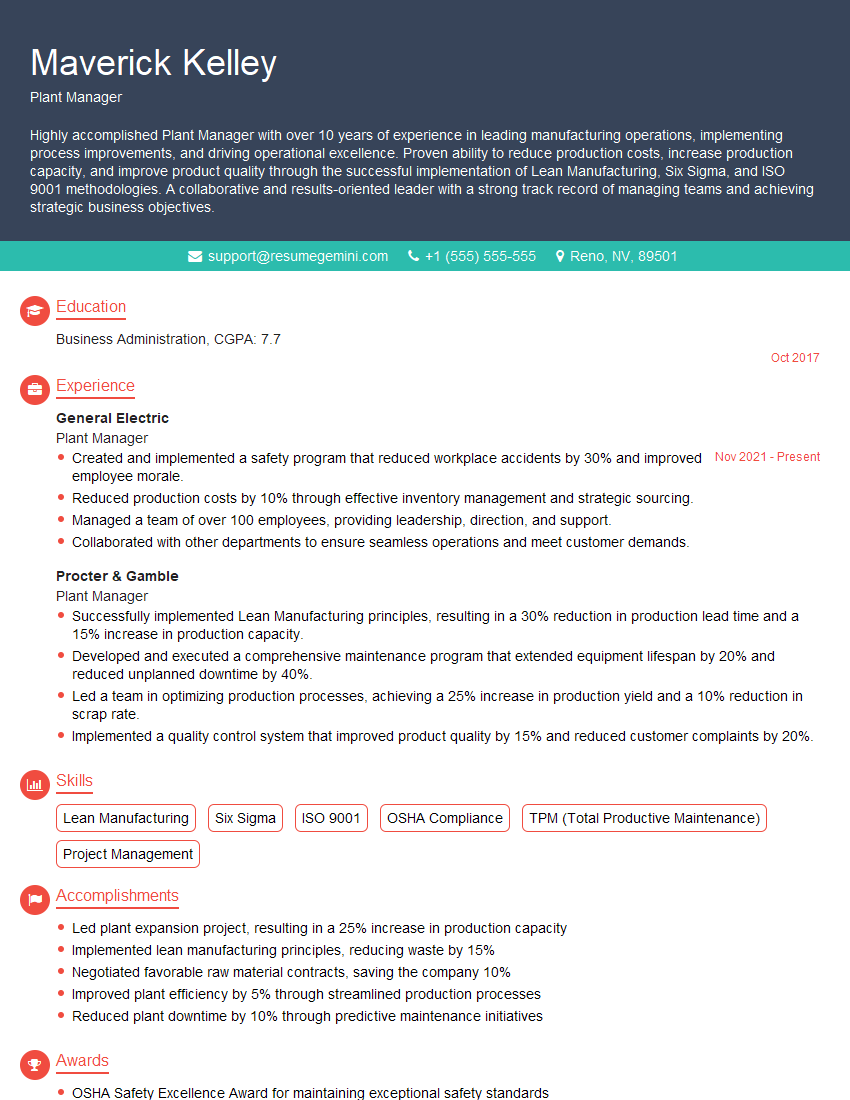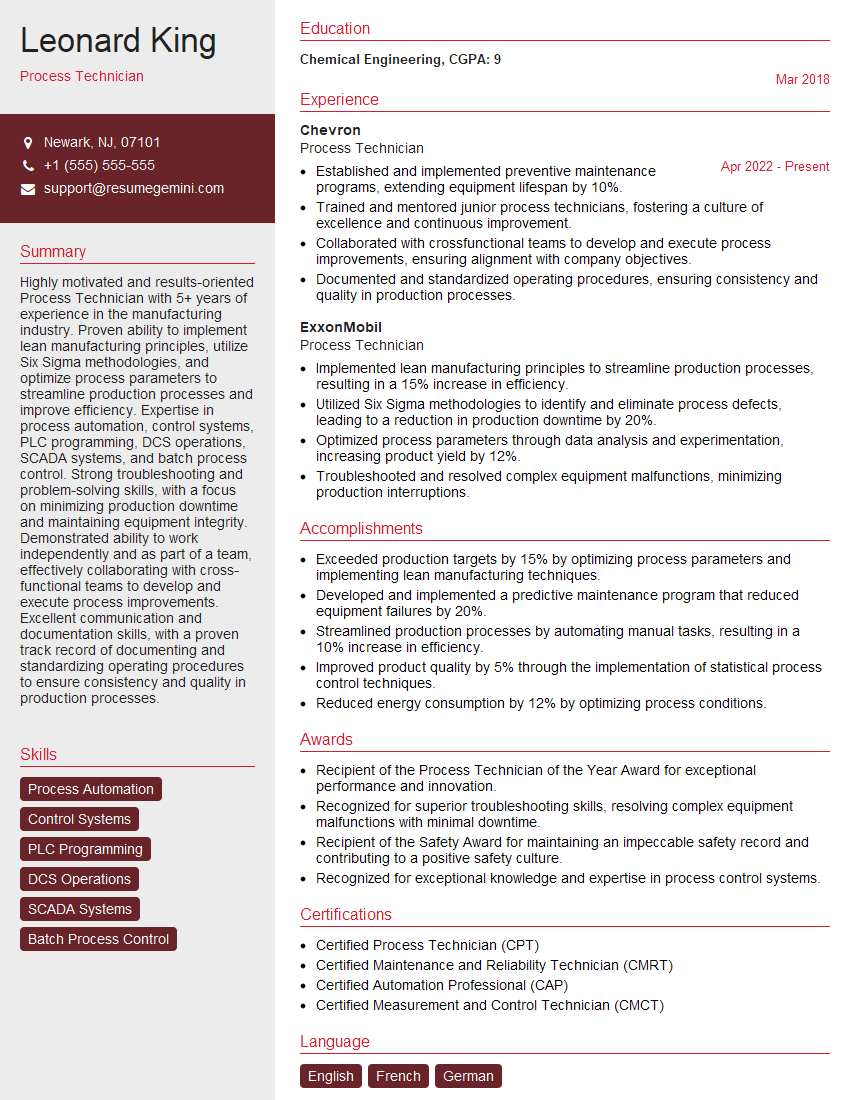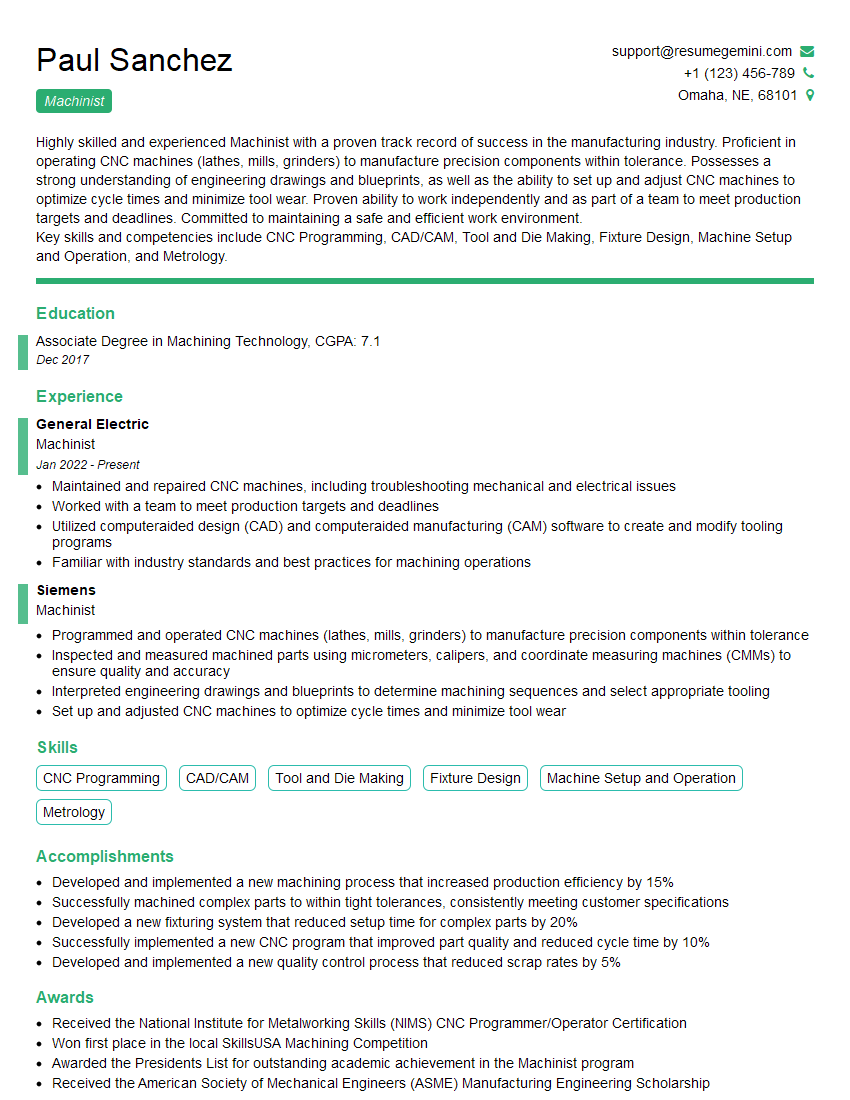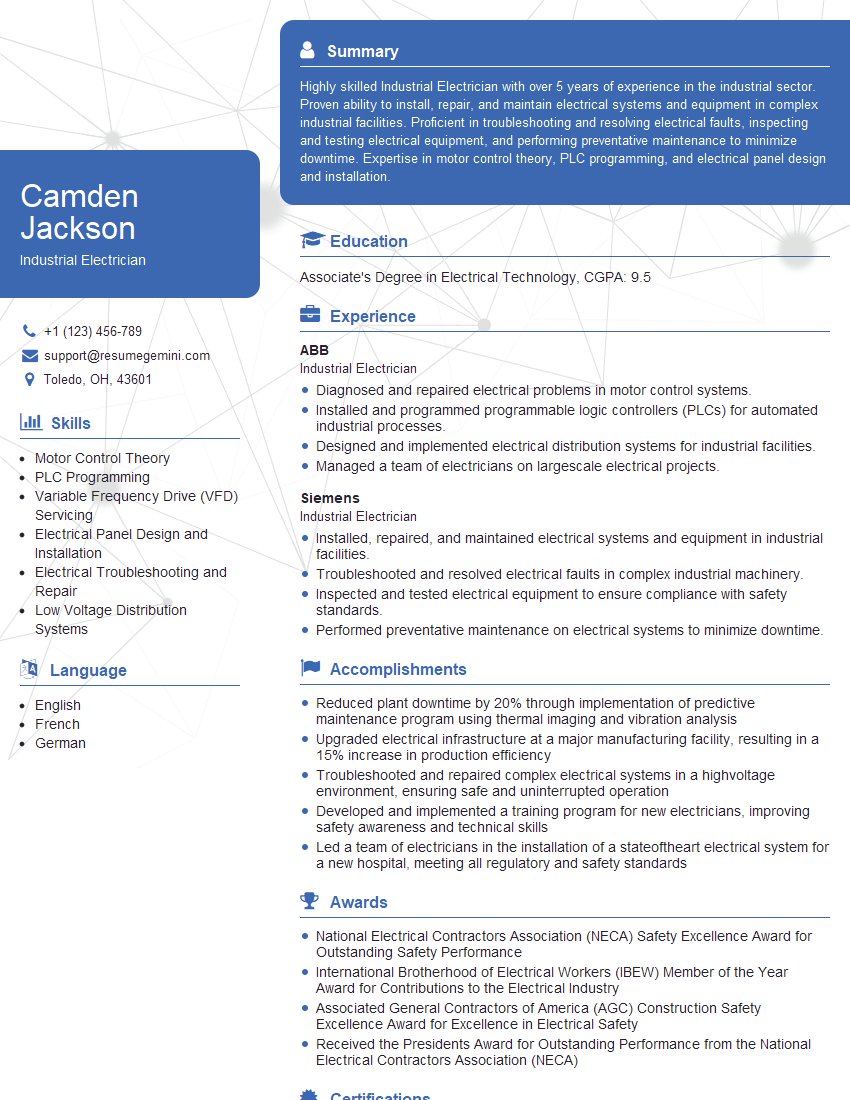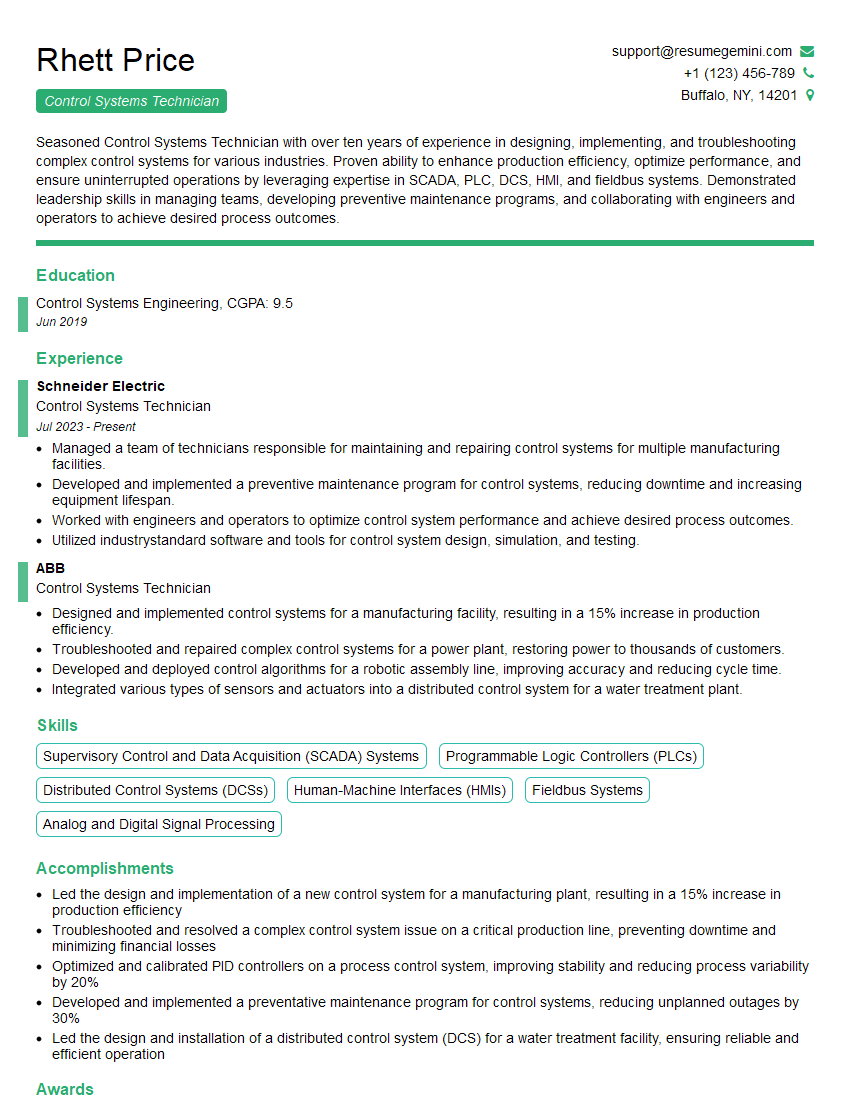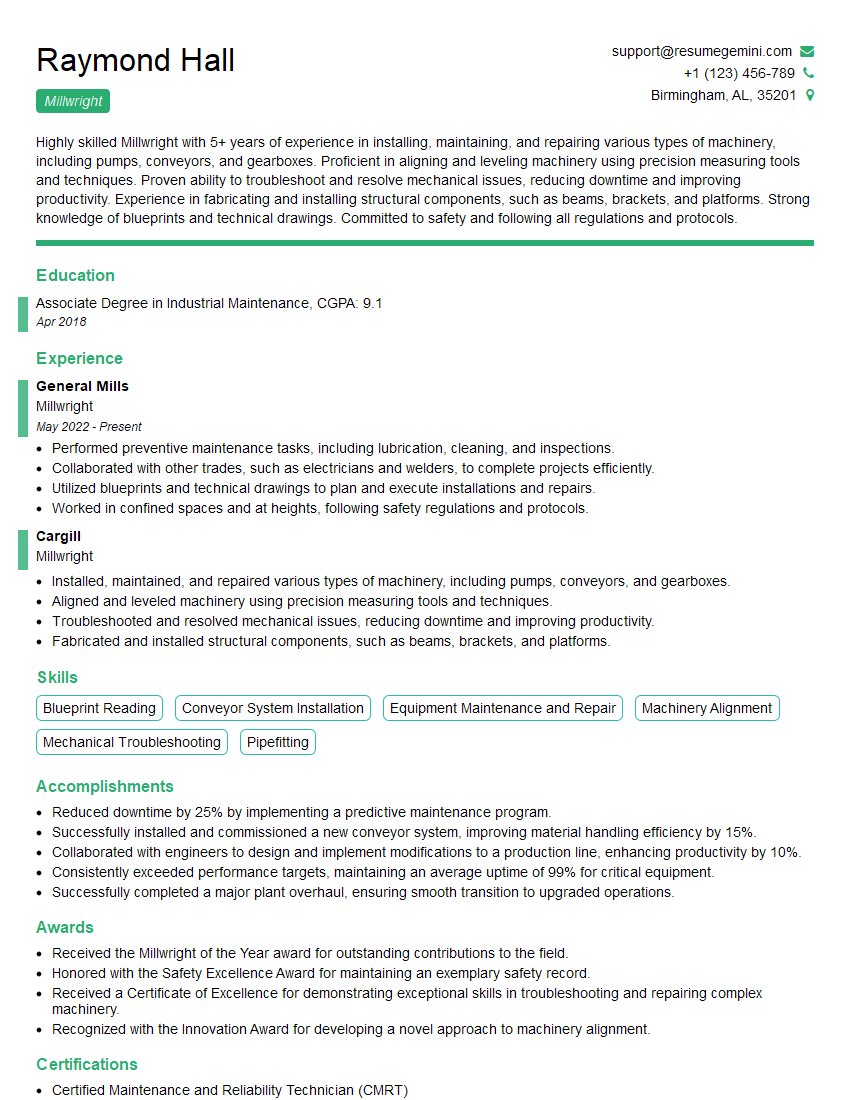Are you ready to stand out in your next interview? Understanding and preparing for Use lockout/tagout procedures interview questions is a game-changer. In this blog, we’ve compiled key questions and expert advice to help you showcase your skills with confidence and precision. Let’s get started on your journey to acing the interview.
Questions Asked in Use lockout/tagout procedures Interview
Q 1. Explain the purpose of lockout/tagout (LOTO) procedures.
Lockout/Tagout (LOTO) procedures are critical safety protocols designed to prevent the unexpected energization or startup of machinery and equipment during maintenance or repair. Their primary purpose is to protect workers from serious injuries or fatalities resulting from accidental release of stored energy.
Think of it like this: before you work on a car engine, you disconnect the battery – LOTO is that, but for industrial machinery and a much broader range of energy sources. It ensures that the equipment is completely de-energized and cannot be accidentally reactivated while someone is working on it.
Q 2. Describe the steps involved in a typical LOTO procedure.
A typical LOTO procedure follows these steps:
- Preparation: Identify the energy sources (electrical, hydraulic, pneumatic, etc.), locate the energy isolation devices (switches, valves, etc.), and gather necessary LOTO devices (locks, tags, and personal protective equipment).
- Notification: Inform all personnel involved in the work and any others potentially affected by the lockout.
- Energy Isolation: Shut down the equipment according to the manufacturer’s instructions and the facility’s safety procedures. This often involves multiple steps to ensure complete isolation.
- Lockout/Tagout Application: Apply a personal lockout device to the energy isolation device, ensuring it cannot be easily bypassed. Attach a tag clearly indicating the work being performed, the employee’s name, and the date.
- Verification: Attempt to restart the equipment to verify that the lockout is effective. The equipment should remain unresponsive.
- Energy Control Verification: Verify that energy sources have been successfully isolated using appropriate testing devices. This step is crucial for confirming the safety of the environment.
- Work Performance: Perform the necessary maintenance or repair work.
- Lockout/Tagout Removal: Once the work is complete, the employee removes their lockout device and tag, verifying that no other employee is still working on the equipment.
- Equipment Restart: After all lockouts have been removed and safety has been confirmed, restart the equipment according to established procedures.
Q 3. What are the potential hazards associated with neglecting LOTO procedures?
Neglecting LOTO procedures can lead to devastating consequences. Potential hazards include:
- Serious injuries or fatalities: Unexpected startup of machinery can cause crushing, burns, electrocution, or other severe injuries.
- Equipment damage: Improper procedures can result in damage to the equipment being serviced.
- Production downtime: Accidents and injuries can lead to significant delays in production.
- Legal liabilities: Companies can face substantial fines and lawsuits due to non-compliance with safety regulations.
- Loss of confidence: Workers may lose confidence in their employer’s commitment to safety, leading to decreased morale.
For example, imagine an electrical panel being worked on without proper lockout; a sudden power surge could easily lead to a fatal shock.
Q 4. How do you identify authorized employees for LOTO?
Authorized employees for LOTO are identified through a combination of factors, including:
- Formal training and certification: Employees must receive comprehensive training on LOTO procedures and demonstrate competency before being authorized.
- Company policy and procedures: Companies establish clear guidelines specifying who can perform LOTO and under what circumstances.
- Job responsibilities: Authorization is often tied to an employee’s specific job role and tasks.
- Competency assessments: Regular evaluations or tests can assess employee knowledge and skills.
There should be a formal record-keeping system that tracks who is authorized to perform LOTO on specific equipment. This prevents unauthorized individuals from attempting to work on energized equipment.
Q 5. Explain the difference between a lockout and a tagout.
While both lockout and tagout aim to prevent accidental energization, they differ in their approach:
- Lockout: A physical device (usually a padlock) that prevents the operation of an energy isolation device. It provides the highest level of physical security, preventing accidental activation.
- Tagout: A warning device (tag) that alerts others not to operate the equipment. It provides a visual warning, but doesn’t offer the same level of physical protection as a lockout.
In many cases, both lockout and tagout are used together for maximum safety. The lock provides physical prevention and the tag acts as visual reinforcement.
Q 6. What are the different types of energy sources that require LOTO?
LOTO applies to various energy sources, including:
- Electrical energy: This is arguably the most common source requiring LOTO, encompassing circuits, transformers, and electrical panels.
- Mechanical energy: Stored energy in springs, compressed air, or rotating equipment needs to be addressed with appropriate LOTO procedures.
- Hydraulic energy: High-pressure hydraulic systems require careful isolation to prevent uncontrolled release of energy.
- Pneumatic energy: Compressed air systems can pose significant hazards if not properly isolated.
- Thermal energy: Hot surfaces, steam, and heated liquids require appropriate measures to prevent burns or scalds.
- Chemical energy: Processes involving chemicals that release energy (e.g., exothermic reactions) require LOTO to mitigate risks.
- Gravitational energy: LOTO may also be needed to secure suspended loads or prevent unintended movement of heavy objects.
The specific energy sources requiring LOTO will vary depending on the industry and the equipment being serviced.
Q 7. Describe the process of verifying the effectiveness of a lockout.
Verifying the effectiveness of a lockout involves several critical steps:
- Attempt to energize: Try to reactivate the equipment using the normal operating controls. The equipment should remain unresponsive, confirming the lockout’s effectiveness.
- Test the energy isolation devices: Use appropriate testing equipment to verify that the energy sources are indeed isolated. This might involve checking voltage levels with a multimeter or using pressure gauges on hydraulic or pneumatic systems.
- Visual inspection: Carefully examine the equipment and isolation devices to ensure that there are no signs of bypassing or compromised safety measures.
- Documentation: Record the lockout verification procedures and results in appropriate documentation to demonstrate compliance with safety procedures.
This verification step is crucial to ensuring that the work area is truly safe before maintenance or repair work begins.
Q 8. What are the responsibilities of an authorized employee during LOTO?
The authorized employee, often a trained and designated individual, holds the primary responsibility for ensuring the safety of the lockout/tagout (LOTO) process. This includes identifying all energy sources, properly isolating them, applying lockout devices, verifying the absence of energy, and releasing the lockout once the work is complete.
- Identifying energy sources: This involves thoroughly assessing the equipment to pinpoint all potential energy sources, such as electrical, mechanical, hydraulic, pneumatic, thermal, chemical, or gravitational energy. For instance, working on a pump might require isolating the electrical power, the hydraulic lines, and potentially even the shaft.
- Applying lockout devices: The authorized employee selects the appropriate lockout devices (locks, tags, etc.) and securely applies them to the energy isolation points. This prevents accidental re-energization of the equipment.
- Verifying energy isolation: Before allowing work to commence, the authorized employee must verify that the equipment is truly de-energized and safe to work on. This often involves testing and double-checking.
- Maintaining control: They retain custody of the lockout devices until the work is finished and they can safely remove them.
Imagine a scenario where an authorized employee is working on a conveyor belt. They’d need to lock out the main power supply, the motor control panel, and potentially any auxiliary power sources, ensuring no accidental startup during maintenance.
Q 9. What are the responsibilities of an affected employee during LOTO?
Affected employees are those who normally operate or work on the equipment being serviced. Their responsibilities are primarily centered around understanding and complying with the LOTO procedure and cooperating with the authorized employee.
- Awareness and Compliance: Affected employees must understand that they cannot operate or energize the equipment during the lockout period.
- Cooperation: They should actively cooperate with the authorized employee and not attempt to bypass or remove the lockout devices.
- Reporting: They should report any unsafe conditions or concerns they observe to the authorized employee or supervisor.
For example, if a machine operator normally works on a press, during a LOTO procedure on that press, the operator is an affected employee and must stay away from the machine and not attempt to restart it, even if they think the work is finished.
Q 10. How do you handle situations where multiple employees need to work on the same equipment simultaneously?
When multiple employees need to work on the same equipment simultaneously, a coordinated LOTO procedure is crucial. This typically involves a designated lead authorized employee who oversees the process and ensures that all lockout devices are properly applied and removed in a controlled manner.
A team approach is needed, where the lead authorized employee establishes clear communication channels and ensures that all team members understand their roles and responsibilities. They might use a group lockout system, where each worker adds their own lock, only removing theirs when all work related to that worker’s actions is complete. A comprehensive checklist that is verified by each team member, before starting and after completing each stage is crucial.
Think of a major plant shutdown; many workers from different teams need to conduct LOTO to specific equipment. A robust and pre-planned system, involving multiple lock-out devices and clear lines of communication is essential to avoid accidents.
Q 11. What are the requirements for LOTO documentation?
LOTO documentation is essential for auditing and accountability. It should clearly record every step of the process.
- Equipment identification: The equipment involved should be clearly identified, including its location and any relevant identifying numbers.
- Energy sources isolated: A list of all energy sources isolated, the specific isolation point, and the method of isolation (e.g., breaker tripped, valve closed) is necessary.
- Lockout/tagout devices used: The type of devices, the employee’s name or ID, and the date and time of application need to be recorded.
- Verification of isolation: Documentation that confirms energy has been successfully isolated.
- Date and time of release: When the lockout devices were removed, signed by the authorized employee, and by whomever verified the removal.
- Employee signatures: Signatures of the authorized employee, affected employees, and supervisors involved.
This detailed record serves as proof that the LOTO procedure was followed correctly, helps in incident investigations, and is crucial for compliance audits. It is often completed on a standardized form to ensure uniformity and completeness.
Q 12. How often should LOTO procedures be reviewed and updated?
LOTO procedures should be reviewed and updated at least annually, or more frequently depending on changes to the equipment, processes, or regulatory requirements. Regular reviews ensure that the procedures remain relevant, effective, and compliant with safety standards.
Any changes in equipment, such as additions or modifications, require immediate review and revision of the LOTO procedure. Similarly, changes to company policies, industry best practices, or regulatory standards necessitate updates to ensure continued compliance and worker safety. Think of it as a living document that needs to adapt to a changing work environment. Regular updates ensure your organization doesn’t inadvertently fall out of compliance and endanger its workforce.
Q 13. What are the common violations related to LOTO?
Common LOTO violations can lead to serious accidents. Some of the most frequent include:
- Improper application of lockout devices: Using inadequate devices, failing to properly secure devices, or not using the correct number of devices for the level of energy.
- Failure to de-energize completely: Not verifying the absence of energy before commencing work.
- Unauthorized removal of lockout devices: An affected employee or anyone bypassing the lockout without the authorized employee’s consent.
- Inadequate training: Employees not receiving the proper LOTO training.
- Lack of communication: Poor communication between authorized and affected employees can lead to misunderstandings and mistakes.
- Poor documentation: Failing to properly document the LOTO process.
These violations often stem from complacency or shortcuts, which undermine the entire purpose of LOTO. A culture of safety and thorough training is key to preventing such violations and ensuring workplace safety.
Q 14. Explain the role of the energy control program in LOTO.
The energy control program is the foundation upon which a successful LOTO system is built. It’s a comprehensive plan that outlines procedures for controlling hazardous energy during maintenance or servicing of equipment. It encompasses everything from employee training and equipment selection to procedure development and documentation. LOTO is a critical element *within* this broader energy control program.
Think of the energy control program as the overall strategy to ensure worker safety when dealing with hazardous energy. LOTO procedures are the tactical steps within that strategy. They describe the specific actions to isolate and control energy for a particular piece of equipment. A comprehensive energy control program is essential for avoiding the many hazards associated with unexpected energization.
Q 15. How do you ensure proper training for all employees involved in LOTO?
Ensuring proper LOTO training is paramount to workplace safety. It’s not a one-size-fits-all approach; training must be tailored to the specific hazards and equipment in the workplace. We start with a comprehensive needs assessment to identify skill gaps. This informs the design of our training program, which includes both classroom instruction and hands-on practical sessions.
Our classroom sessions cover the theory behind LOTO, legal requirements (like OSHA guidelines), the company’s specific LOTO procedures, and the identification of hazardous energy sources. We emphasize the importance of proper lockout/tagout device selection and application. The practical sessions allow employees to practice using different lockout devices on various equipment under the supervision of experienced trainers. We use realistic scenarios, including simulated emergencies, to reinforce learning and build confidence.
Regular refresher training is crucial to maintain competency. We conduct these sessions annually or more frequently if there are changes in procedures or equipment. We also track training completion and competency levels using a robust training management system, providing continuous improvement opportunities. Finally, successful completion is always confirmed through both written and practical assessments, ensuring each employee truly understands and can apply the procedures.
Career Expert Tips:
- Ace those interviews! Prepare effectively by reviewing the Top 50 Most Common Interview Questions on ResumeGemini.
- Navigate your job search with confidence! Explore a wide range of Career Tips on ResumeGemini. Learn about common challenges and recommendations to overcome them.
- Craft the perfect resume! Master the Art of Resume Writing with ResumeGemini’s guide. Showcase your unique qualifications and achievements effectively.
- Don’t miss out on holiday savings! Build your dream resume with ResumeGemini’s ATS optimized templates.
Q 16. Describe a time you had to troubleshoot a LOTO procedure.
During a recent maintenance shutdown, we encountered a problem with a specific piece of machinery. The existing LOTO procedure called for isolating the power supply through a main breaker. However, the machinery also had a secondary power source that wasn’t clearly identified in the original procedure. This wasn’t immediately apparent; it was only during the lockout process that we discovered this secondary supply, which continued to energize parts of the equipment.
Our troubleshooting involved reviewing the machinery’s electrical schematics and contacting the manufacturer for clarification. We discovered a poorly documented backup power system. Immediately, we halted the procedure, convened a safety meeting, and developed a revised LOTO procedure that explicitly addressed this secondary power source, requiring its isolation before proceeding. The update included detailed diagrams and clear instructions for identifying and isolating all energy sources. Following the updated procedure, the maintenance was completed safely.
Q 17. How do you handle emergency situations during a LOTO procedure?
Emergency situations during a LOTO procedure require immediate and decisive action. Our protocol prioritizes the safety of personnel first and foremost. The first step is to ensure everyone is clear of the hazardous area.
If an unexpected energization occurs despite the LOTO procedure being in place, we initiate an emergency shutdown using the emergency stop buttons (if available) and any other appropriate emergency shut-off methods. We immediately evacuate the area and initiate our established emergency response plan. This includes notifying emergency services and conducting a thorough investigation to determine the root cause of the energization and to prevent future incidents. The investigation includes checking all lockout devices to ensure proper implementation, examining the equipment for potential malfunctions, and potentially reviewing the LOTO procedure itself.
Q 18. What are the key elements of an effective LOTO program?
An effective LOTO program is multifaceted and relies on several key elements. First, it requires a strong commitment from leadership to prioritize safety. This commitment must be demonstrated through resource allocation and the enforcement of procedures.
- Comprehensive Energy Isolation Procedures: Detailed, equipment-specific procedures for safely isolating all potential energy sources (electrical, hydraulic, pneumatic, etc.).
- Employee Training and Competency: Thorough and regularly updated training programs to ensure all employees understand and can correctly apply the LOTO procedures.
- Lockout/Tagout Device Management: A system for procuring, inspecting, and maintaining lockout devices to ensure their effectiveness.
- Regular Audits and Inspections: Regular inspections to ensure compliance with the procedures and identify areas for improvement.
- Incident Reporting and Investigation: A robust system for reporting near misses and incidents, conducting thorough investigations, and implementing corrective actions.
- Communication and Documentation: Clear communication channels and well-maintained documentation of all procedures, training, and incidents.
An effective LOTO program treats it as an ongoing process of continuous improvement, learning from past experiences, and adapting to changing circumstances.
Q 19. Describe your experience with various types of lockout devices.
My experience encompasses a wide range of lockout devices, including:
- Padlocks: These are the most common devices, offering individual accountability with easily identifiable keys or combination locks.
- Lockout Hasps: These allow multiple employees to attach their lockout devices to a single energy isolation point, increasing safety during group maintenance.
- Cable Locks: Useful for isolating larger equipment or multiple energy sources simultaneously.
- Circuit Breakers with Lockout Mechanisms: These integrated systems offer convenience and prevent unauthorized access.
- Valve Lockout Devices: Specialized devices used to secure valves in various types of systems, including hydraulics and pneumatics.
Selecting the right device depends on the specific energy source and the equipment involved. It is also critical to ensure that all devices are regularly inspected and maintained to confirm their functionality.
Q 20. How do you manage LOTO procedures during maintenance shutdowns?
Managing LOTO during maintenance shutdowns requires meticulous planning and coordination. We begin by identifying all equipment requiring lockout, developing a detailed LOTO schedule, and assigning responsibility for each energy isolation point. Pre-shutdown meetings with all involved personnel are critical to ensure everyone is fully briefed and understands their role.
A key aspect is the establishment of a centralized control point for all LOTO activities. This central point allows for effective communication, coordination, and real-time monitoring of the lockout/tagout process throughout the shutdown. After the maintenance work is completed, the devices are removed in a controlled manner, following the same sequential order as their implementation. Every step, including the verification of energy isolation and the removal of locks, is documented carefully. Finally, a post-shutdown review is essential to identify lessons learned and areas for improvement.
Q 21. What are some common misconceptions about LOTO?
Several common misconceptions surround LOTO. One prevalent misunderstanding is that LOTO is only necessary for major maintenance. In reality, LOTO should be used for any work where there is potential for accidental energization, regardless of the complexity of the task. Another misconception is that only electricians need LOTO training; in fact, anyone who might work on or near equipment with potential energy sources requires thorough LOTO training.
Sometimes, there’s a belief that simply de-energizing equipment without using a lockout device is sufficient. This is incorrect; a lockout device physically prevents the re-energization of the equipment, even if someone inadvertently tries to restore power. Finally, some believe that only one type of lockout device is sufficient for all equipment. This is false; the appropriate device must be selected based on the specific energy source and isolation point.
Q 22. How do you address resistance to following LOTO procedures?
Resistance to LOTO procedures often stems from a lack of understanding, perceived inconvenience, or a rushed work environment. Addressing this requires a multi-pronged approach. First, comprehensive training is crucial – employees need to understand why LOTO is essential for their safety and the safety of others. This training should go beyond simple procedure memorization and emphasize the potential consequences of non-compliance, using real-life examples of accidents caused by energy-related incidents. Second, actively involve employees in the development and improvement of LOTO procedures. This fosters ownership and buy-in. Third, make the process as efficient as possible. Streamlined procedures, readily available equipment, and clear signage can minimize disruptions. Finally, consistent monitoring and enforcement are key. Addressing minor infractions promptly and fairly shows that LOTO is a serious commitment, not just a formality. For example, in a previous role, I implemented a system of regular toolbox talks focusing on LOTO best practices and near-miss reporting, significantly reducing resistance.
Q 23. How do you ensure compliance with OSHA regulations regarding LOTO?
Ensuring OSHA compliance regarding LOTO involves a holistic approach. It begins with a thorough understanding of OSHA 29 CFR 1910.147, the standard outlining LOTO requirements. This includes conducting regular energy-hazard assessments to identify all potential sources of hazardous energy in the workplace. These assessments should be documented, reviewed, and updated as needed. Based on these assessments, we develop and implement comprehensive LOTO procedures specific to each piece of equipment and task. Crucially, these procedures must be written clearly, concisely, and in a language understandable to all employees. Regular training, competency verification, and documented audits are essential to demonstrate compliance. We also maintain detailed records of LOTO activities, including who performed the lockout/tagout, the date and time, and the equipment involved. Periodic inspections of the LOTO devices and equipment are also vital. This detailed record-keeping allows for traceability and helps in case of accidents or audits. In my experience, proactively addressing potential non-compliance issues and continuously improving our LOTO program has been vital for maintaining our OSHA compliance.
Q 24. Explain your understanding of the hierarchy of controls for energy isolation.
The hierarchy of controls for energy isolation prioritizes the most effective methods to eliminate or minimize hazards. It follows a tiered approach:
- Elimination: This is the most preferred method. It involves physically removing the hazard altogether, such as replacing a dangerous piece of equipment with a safer alternative.
- Substitution: If elimination isn’t feasible, substituting the hazard with a less hazardous option is the next best step, like using a low-voltage system instead of a high-voltage one.
- Engineering Controls: This involves implementing physical changes to the equipment or workplace to reduce or eliminate the hazard. Examples include using guarding, interlocks, or remote control systems.
- Administrative Controls: These involve changes to work practices, such as implementing standardized procedures, providing training, and establishing clear communication protocols. LOTO is a key component of administrative controls.
- Personal Protective Equipment (PPE): This is the least effective method and should only be used as a last resort after all other measures have been implemented. PPE only protects the individual wearing it, not the source of the hazard.
Ideally, we strive to utilize the higher levels of the hierarchy first before relying on PPE. For instance, if a machine repeatedly causes injuries, we would first explore eliminating the machine and replacing it with an automated system (elimination), then explore engineering solutions like adding safeguards (engineering controls), before finally providing safety glasses (PPE) if the engineering control is not entirely sufficient. The goal is to progressively reduce risk.
Q 25. How do you incorporate LOTO procedures into a preventative maintenance plan?
Integrating LOTO procedures into a preventative maintenance plan is crucial for ensuring worker safety during maintenance activities. The maintenance schedule should specifically include steps for de-energizing and isolating equipment before any work begins. This involves identifying all energy sources affecting the equipment being serviced. Clear LOTO procedures should be included in the work order for each maintenance task, and the responsible technician should be thoroughly trained on those procedures. After completing the maintenance work, the technician should follow the outlined steps for verifying energy isolation and releasing the lockout/tagout. Additionally, the maintenance log should document all LOTO activities performed. This thorough integration ensures that equipment is safely de-energized before maintenance, reducing the risk of accidental energy release during the process. A good example is including a checklist within the maintenance work order that must be signed off at each step of the LOTO process – this ensures accountability and thoroughness.
Q 26. What is your experience with auditing LOTO procedures?
My experience with auditing LOTO procedures involves a systematic approach. I begin by reviewing the existing LOTO program documentation, including the written procedures, training records, and incident reports. Then, I conduct onsite observations to assess the actual implementation of the procedures. This includes watching employees perform LOTO, observing the condition of the lockout devices, and assessing the overall workplace safety culture. Throughout the process I verify compliance with OSHA standards and company policies. I am particularly observant about the consistency and thoroughness of LOTO procedures across different departments and employees. This ensures everyone is using the same safety protocols. Finally, I prepare a comprehensive report that outlines my findings and recommendations for improvement. This report focuses on both areas of compliance and areas needing attention. My approach is collaborative – I work with the organization to implement those improvements and ensure their long-term sustainability.
Q 27. How would you improve a company’s existing LOTO program?
Improving a company’s LOTO program starts with a thorough assessment of the existing program’s strengths and weaknesses. This can include conducting a gap analysis against OSHA standards and best practices. I would then focus on several key areas. First, improve training. This might involve updating training materials, using more engaging training methods, and ensuring employees fully understand the rationale behind LOTO procedures. Second, enhance procedural clarity and usability. Ambiguous or overly complex procedures are more likely to be ignored. Third, ensure proper equipment maintenance. Outdated or malfunctioning lockout devices render the entire system ineffective. Fourth, incorporate regular audits and inspections to maintain compliance. This should include both planned and unplanned audits to ensure consistency. Fifth, foster a strong safety culture by promoting employee involvement and recognizing safe work practices. This could include employee suggestion boxes and regular safety meetings. Finally, address any shortcomings uncovered during incident investigations to implement preventive measures. By systematically tackling these key areas, we can significantly enhance a company’s LOTO program effectiveness and safety.
Q 28. Describe your experience with LOTO-related incidents and how they were handled.
In my career, I’ve been involved in investigating several LOTO-related incidents, ranging from near misses to minor injuries. One particular case involved a technician who inadvertently bypassed a lockout device due to time pressure and a poorly defined procedure. The incident resulted in a minor electrical shock. The investigation revealed flaws in both the training and the procedure itself. We addressed this by implementing revised and clearer procedures, enhancing training with real-life scenarios and emphasizing the importance of never bypassing safety procedures, no matter the time constraint. We also implemented additional procedural checks, along with a detailed root-cause analysis to prevent future occurrences. After improving the processes and training, we saw a noticeable reduction in near-misses and a much higher level of awareness among staff. Every incident, even near-misses, presents an opportunity to learn and reinforce the importance of safety through thorough investigation and proactive adjustments to our LOTO program.
Key Topics to Learn for Use lockout/tagout Procedures Interview
- Understanding Lockout/Tagout (LOTO) Fundamentals: Define LOTO, its purpose, and the critical role it plays in workplace safety. Understand the legal and regulatory frameworks surrounding LOTO procedures.
- The LOTO Process Step-by-Step: Master the sequence of actions involved in a complete LOTO procedure. This includes identifying energy sources, isolating energy sources, applying lockout devices, verifying isolation, and releasing the lockout.
- Types of Energy Sources and Control Methods: Learn to identify and control various energy sources (electrical, mechanical, hydraulic, pneumatic, etc.) and the appropriate lockout/tagout devices for each.
- Hazard Identification and Risk Assessment: Understand the importance of properly assessing potential hazards before commencing any work involving energy sources. Learn how to identify and mitigate risks associated with LOTO procedures.
- Proper Selection and Application of Lockout Devices: Learn about different types of lockout devices (padlocks, lockout hasps, etc.) and their appropriate application based on the energy source and situation.
- Teamwork and Communication in LOTO: Understand the importance of clear communication and teamwork when multiple individuals are involved in a LOTO procedure. Discuss best practices for safe and efficient collaboration.
- Troubleshooting and Problem Solving: Be prepared to discuss potential challenges encountered during LOTO procedures and effective strategies for troubleshooting and resolving issues.
- Documentation and Record Keeping: Understand the importance of maintaining accurate and complete records of all LOTO procedures performed.
- Compliance and Audits: Familiarize yourself with regulatory compliance requirements and the process of LOTO audits.
Next Steps
Mastering lockout/tagout procedures demonstrates a strong commitment to safety and a high level of technical proficiency – skills highly valued by employers. This expertise significantly boosts your career prospects in many industries. To make your qualifications shine, creating an ATS-friendly resume is essential. ResumeGemini is a trusted resource for building professional resumes that catch the eye of recruiters. ResumeGemini provides examples of resumes tailored to highlight Use lockout/tagout procedures expertise, helping you present your skills effectively. Invest the time to build a strong resume – it’s an investment in your future.
Explore more articles
Users Rating of Our Blogs
Share Your Experience
We value your feedback! Please rate our content and share your thoughts (optional).
What Readers Say About Our Blog
Hi, I’m Jay, we have a few potential clients that are interested in your services, thought you might be a good fit. I’d love to talk about the details, when do you have time to talk?
Best,
Jay
Founder | CEO

